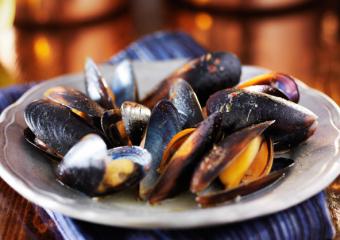
Manganese is an essential mineral that is involved in bone formation and aids in the digestion of cholesterol, carbohydrates and protein. To meet daily recommendations for manganese intake, individuals should be sure to include a variety of nuts, legumes and seeds in their diet.
Nuts and Seeds
In Nutrition Therapy and Pathophysiology (page 523), nuts are listed as good sources of manganese. Here are examples of the manganese content in one-ounce serving of nuts:
Beans
One serving of beans - the equivalent of a half-cup - contains the following amounts of manganese:
- Garbanzo beans, cooked - 0.85 mg
- Lima beans, cooked - 0.49 mg
- Navy beans, cooked - 0.48 mg
- Pinto beans, cooked - 0.39 mg
Grains
Grains are also a rich source of manganese:
- Oats (1/4 cup) -- 1.92 mg
- Quinoa (3/4 cup) - 1.19 mg
- Brown rice, cooked (1/2 cup) - 1.07 mg
- Whole wheat bread (1 slice) - 0.60 mg
Fruit
According to the Linus Pauling Institute, a half-cup serving of fruit or fruit juice contains the following amounts of manganese:
- Raw pineapple, cut into cubes - 0.77 mg
- Pineapple juice - 0.63 mg
- Cranberry juice - 0.59 mg
- Raspberries - 0.41 mg
- Strawberries - 0.28 mg
- Blueberries - 0.25 mg
Vegetables
A half-cup serving of certain vegetables can provide a good amount of manganese:
- Spinach, cooked - 0.84 mg
- Sweet potato, cooked, mashed - 0.44 mg
- Swiss chard - 0.29 mg
- Turnip greens - 0.25 mg
- Kale, chopped - 0.20 mg
- Mustard greens - 0.19 mg
- Summer squash - 0.19 mg
Meat and Vegetarian Alternatives
Healthaliciousness lists the following amounts of manganese in each three-ounce serving of these meats and vegetarian alternatives:
- Mussels, cooked - 5.80 mg
- Tofu, firm, raw - 1.50 mg
- Tempeh, raw - 1.46 mg
- Bass, cooked - 1.0 mg
Herbs and Spices
A two-teaspoon serving of some herbs and spices are a rich source of manganese:
- Cloves - 2.53 mg
- Cinnamon - 0.91 mg
- Black pepper - 0.74 mg
Beverages
Eight fluid ounces of each of the following beverages is rich in manganese:
- Black tea, brewed - 0.80 mg
- Coffee, brewed - 0.50 mg
Recommended Dietary Allowance
According to Eating Well, adults and children should try to include the following number of milligrams of manganese in their diets on a daily basis:
- Infants 0 - 6 months - 0.003 mg
- Infants 7 - 12 months - 0.6 mg
- Children 1 - 3 years - 1.2 mg
- Children 4 - 8 years - 1.5 mg
- Children 9 - 13 years - 1.9 mg
- Children 14 - 18 years - 2.2 mg
- Males 19 years and up - 2.3 mg
- Females 19 years and up - 1.6-1.8 mg
Manganese Matters
While some individuals choose to meet the body's manganese requirements through the use of over-the-counter supplements, this doesn't have to be the case. By following a healthy, balanced diet, most individuals can easily meet manganese demands through whole foods alone. Be sure to eat a variety of seeds, nuts, beans, and legumes for optimal results when it comes to adding manganese to your diet. Choosing specific fruits and vegetables can also be helpful when it comes to supplementing manganese intake.







